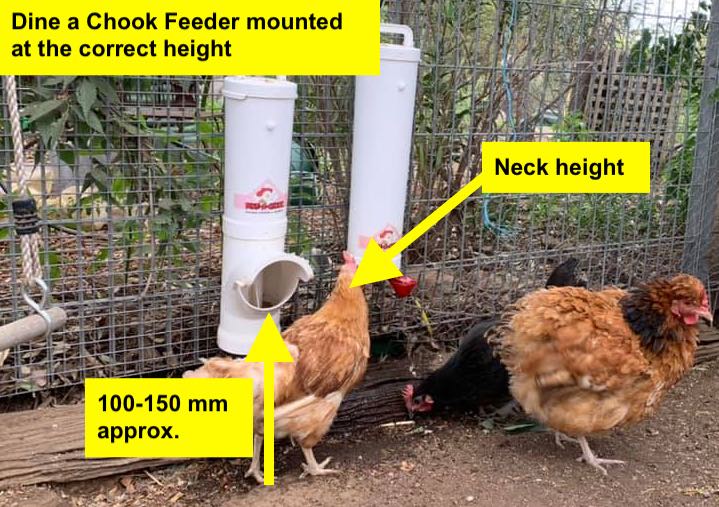Dine-A-Chook Chicken Feeder Installation and Use
This page contains everything that you need to know about your new Chicken Feeder. Use the Table of Contents to jump directly to the information that you need.
Table of Contents
1. What types of chickens and poultry can use a Dine a Chook Feeder?
3. Tips for getting your birds to use a new Dine a Chook Feeder
5. Dealing with rodents and pests
6. Dine a Chook Feeder FAQs and Trouble-shooting
1. What types of birds can use a Dine a Chook Feeder?
Dine a Chook Feeders are suitable for all types of chickens, including bantams and roosters, from about 6 weeks of age. Only show chickens with exceptionally large combs may struggle to access the feeding bay.
Dine a Chook Feeders can also be used by other birds and poultry, including:
- Ducks
- Geese
- Guinea fowl
- Turkeys
- Pheasants
The Billabong Wildlife Sanctuary in Townsville even uses a Dine a Chook to feed their emus!
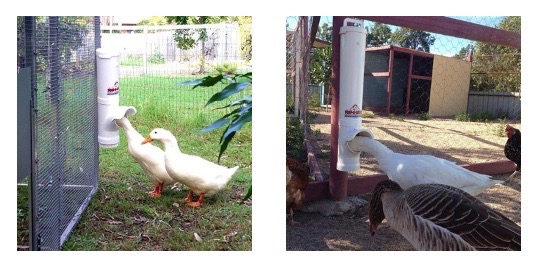
2. Installing a Dine a Chook Chicken and Poultry Feeder
Where to put your Feeder
Dine a Chook Feeders can be installed outside, as they are made of UV-treated ASA thermoplastic designed for outdoor use. They won't break or become brittle if exposed to sunlight, although colour fading is possible.
Dine a Chook Feeders are water-tight and won't leak even in tropical downpours!
However, we recommend installing your Feeder in the shade as direct sunlight warms the chicken feed, causing spoilage.
In most cases, we recommend installing your Feeder in the chicken coop or a pest-proof run. This protects the Feeder from livestock (not including poultry) and wildlife. Although our Feeders are designed to deter pest animals, they are more likely to be used by rodents and wild birds if installed outside of the coop.
Choosing the correct mounting height
The correct mounting height for a Dine a Chook Feeder will vary depending on the type of poultry, breed and age of the birds. Choose your mounting height to suit the largest bird in your flock and provide a step for smaller birds.
In mixed flocks where size differs, we recommend installing 2-3 units at different heights. In flocks of mixed poultry, ducks and even geese will usually happily use Feeders that have been mounted for chickens to feed comfortably.
Always monitor new Feeders carefully after installation to ensure that all birds can comfortably access the feed, and adjust the height as needed.
Feeder height
Dine a Chook Feeders are designed to be mounted so that the feeding bay is at “chicken height”. This means at roughly the height of the back of the bird’s neck, about 100-150 mm off the floor.
Mounting your Feeder at the correct height is important for the waste-reducing and pest-deterrent features to work correctly, as well as for your birds to eat comfortably.
Some chicken keepers choose to mount their Feeder higher and provide a step for all of their birds, as this makes it more difficult for pests to access the feeding bay.
Providing a step
Where a Feeder is mounted for larger birds, a step can be provided for the smaller birds in your flock. Anything sturdy, such as pavers, bricks or timber, will do.
Steps can be placed directly in front of the Feeder or Drinker. In a situation with various sized birds, it is recommended that steps are placed slightly to one side.
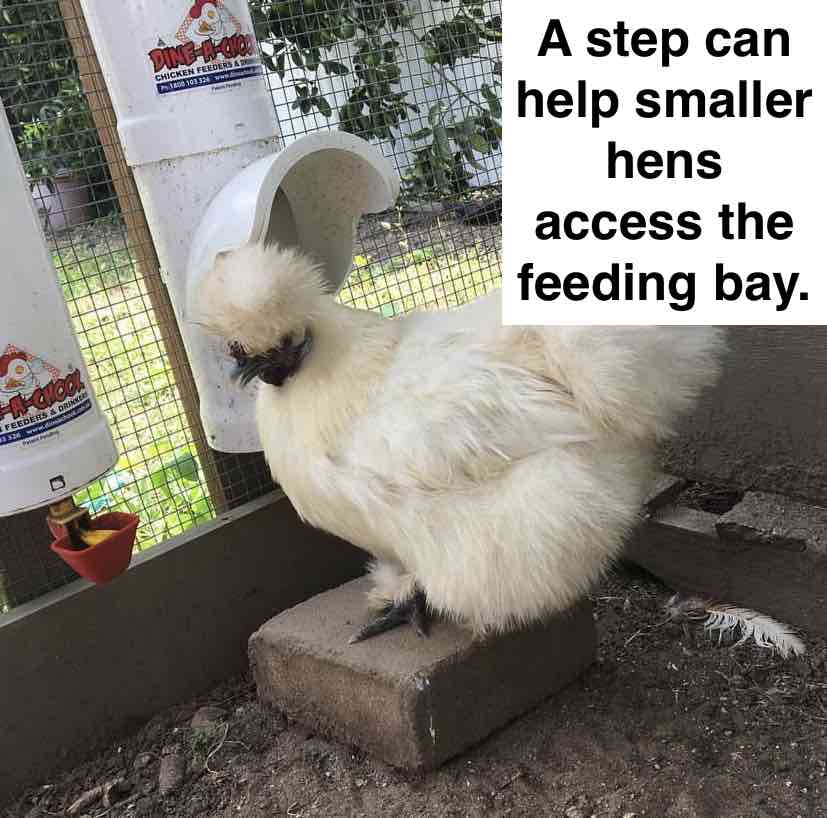
Dine a Chook Feeder Installation Instructions
Please note the following points:
- Feeders must be installed using the custom-made steel brackets supplied in the complimentary Mounting Kit. They should never be hung directly by the rear mounting hooks, with string or wire, or by any other means.
- Although units may have 3 rear mounting hooks, they should be mounted using the top and bottom hooks
- Brackets must be snug against the top of the hooks and weight evenly distributed between both hooks
- For installation on wire mesh, we recommend purchasing a Wire Mesh Mounting Kit as washers and nuts will be required to mount the brackets
- Failure to follow these instructions may void the product warranty
Solid surface installation
Follow these instructions to install your Feeder on a solid surface such as timber, steel or masonry.
To install your Feeder unit, you will need:
1 x Complementary Dine a Chook Mounting Kit (2 steel brackets + 4 screws)
1 x Drill with a Phillips head bit
For installation on concrete or masonry, alternative screws may be required.
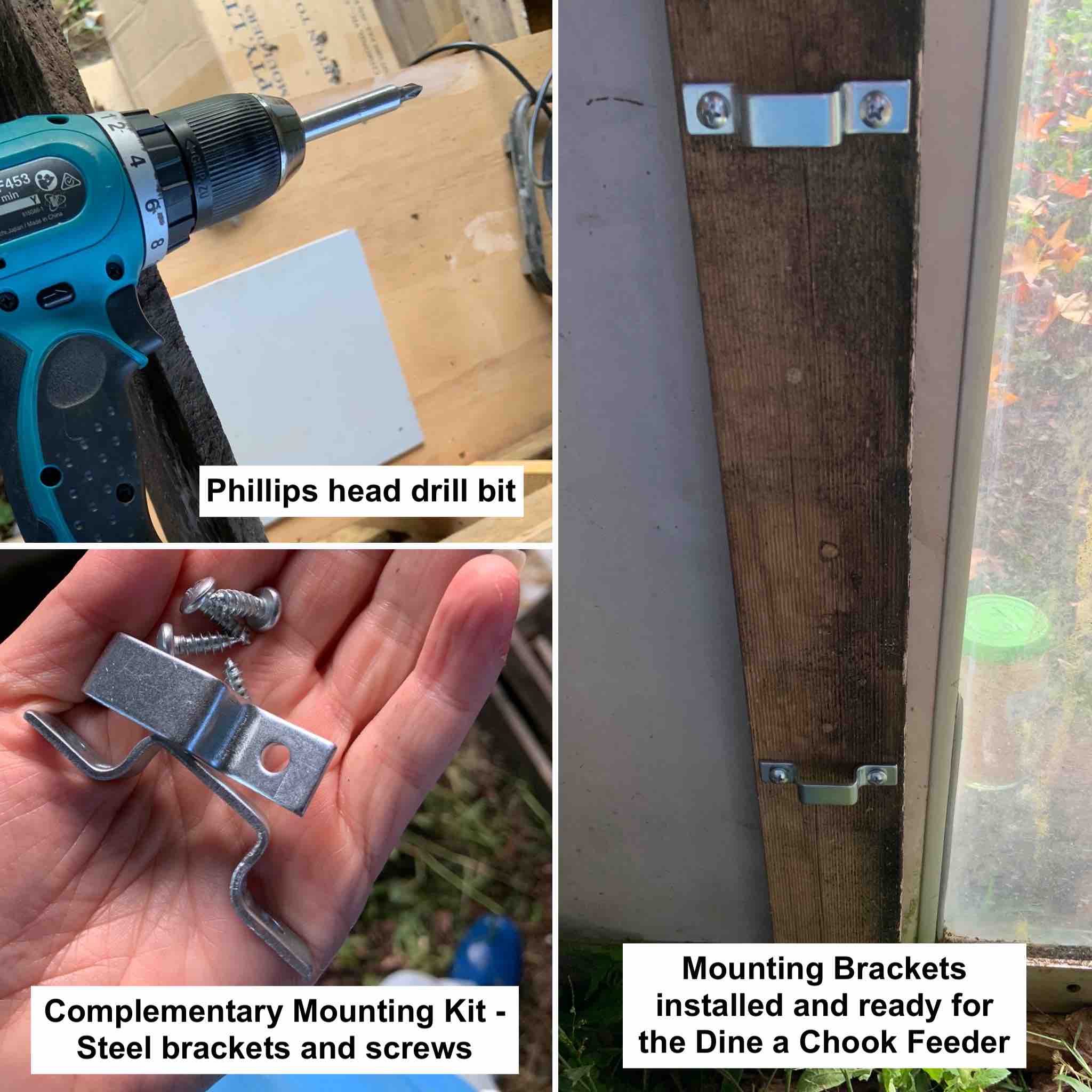
Steps to install a Dine a Chook Feeder on a solid surface:
- Determine the correct height for the Feeder (see above)
- Slip a steel bracket onto the top mounting hook
- Hold the unit against the mounting surface at the correct height
- Mark the bracket location or simply hold the bracket firmly in place and remove the unit
- Screw the bracket into place using the supplied screws. On some surfaces, you may need to pre-drill a hole in which case marking the bracket location is recommended.
- Hang the unit from the top bracket
- Slip the second bracket onto the bottom mounting hook, ensuring it is snug at the top of the hook so that weight is distributed equally between both brackets
- Mark the location of the second bracket or hold in place and remove the unit
- Screw the second bracket into place
- Hang your Feeder unit and check that weight is evenly distributed between the mounting hooks
Always monitor your flock after installing a new Feeder to ensure all birds can comfortably access feed.

Wire mesh installation
All Dine a Chook Feeders come with a complementary Mounting Kit. For wire mesh installation, we recommend the additional purchase of a Wire Mesh Mounting Kit.
Please note that units must be hung using the supplied mounting brackets to meet warranty conditions and should not be hung directly onto wire mesh using the rear mounting hooks.
To install your Feeder unit, you will need:
1 x Complementary Dine a Chook Mounting Kit (2 steel brackets + 4 screws)
1 x Dine a Chook Wire Mesh Mounting Kit (4 bolts, 4 washers + 4 nuts)
You may need pliers and/or a shifter to tighten the nuts. An additional person to help is also handy.

Steps to install a Dine a Chook Feeder on wire mesh:
- Determine the correct height for the Feeder unit (see above)
- Slip a steel bracket onto the top mounting hook
- Hold the unit against the wire mesh at the correct height
- Slip a bolt through the bracket and mesh, ensuring it is resting on a horizontal wire
- Slip a washer and nut onto the back of the bolt and tighten loosely
- Repeat on the other side of the bracket and then tighten both sides evenly
- Hang the unit from the top bracket
- Slip the second bracket onto the bottom mounting hook, ensuring it is snug at the top so that weight is distributed equally between both brackets
- Slip a bolt through the bracket and mesh, ensuring it is resting on a horizontal wire
- Slip a washer and nut onto the back of the bolt and tighten loosely
- Repeat on the other side and then tighten both sides evenly
- Hang your Feeder unit and check that weight is evenly distributed between the mounting hooks
Always monitor your flock carefully to ensure all birds are able to comfortably reach the feed.

3. Tips for getting your birds to use a new Dine a Chook Feeder
Most chickens and other domestic birds will easily learn to use a Dine a Chook Feeder without any special training. You can help your chickens adapt to the new Feeder by:
- Removing any other feeders from your chicken coop - Chickens are creatures of habit, and if the old feeder is still there, they will use it instead of the new Feeder.
- Avoiding scraps and other treats for a few days - This will ensure your chickens need to eat their feed out of the new Feeder, as they haven't filled up on scraps.
Give your chickens a few hours to find the new Feeder and try it out. If they still aren't using it, try some of the following tricks.
Tips to get your birds to use a Dine a Chook
- Place some of your chickens favourite treats in the mouth of the Feeder - Dried Mealworms work a treat! You can even make a path of treats leading to the Feeder.
- Place a dish of feed or treats under the mouth of the feeding bay, so your chickens learn to associate the new Feeder with food.
- Teach one of your more docile hens to use the Feeder - she will easily teach the rest of the flock!
- Temporarily adjust the feeding bay depth to make the feeding bay shallower. This makes feed more visible from the mouth of the Feeder. However, with many feeds this will prevent the feeding bay from filling automatically, so this should only be a temporary measure.
- Pour a few more cups of feed into the feeding bay from the mouth of the Feeder, so that feed is level with the lip of the feeding bay. This will make feed easier to see and access, encouraging your chickens to use the new Feeder. However, this should only be done as an initial encouragement as overfilling the feeding bay will cause spillage. Be careful not to overfill at the back of the Feeder or feed can become jammed and spoil.
Reasons why chickens might not be using the Feeder
If you have given your chickens time to adapt to the new Feeder and removed all other sources of food, and they are still not using their new Dine a Chook, there are a few common reasons why this might be the case:
- The Feeder has been mounted too high for your chickens - add a step or remount at a lower height
- The feeding bay depth is so low that your chickens cannot reach the feed - add a step and/or make the feeding bay shallower (see instructions in the FAQ section below). If this obstructs refilling, you may need to choose a smaller particle feed such as a mash.
- The feeding bay is not automatically refilling - adjust the feeding bay depth (see instructions below) and ensure you are using an appropriate type of feed
- Dominant birds are guarding the Feeder, preventing other hens from eating - install a second Feeder in another location
If just a few birds aren't using the Feeder, bullying, Feeder height and too few Feeders for the size of the flock are the most common culprits. There are also other factors than can cause decreased appetite in chickens including hot weather, dehydration and disease, as well as installing the Feeder in the sun so the feed becomes warm and problems such as stale, mouldy, rancid or contaminated feed.
4. Choosing the best feed for your chickens
A good diet is one of the most important factors for productive and healthy hens. Many of the problems we see in backyard flocks are caused by a poor diet. Follow our simple advice for happier, healthier chooks that lay more eggs.
You can learn more about optimum nutrition for laying hens on our blog.
What is the best diet for laying hens?
So many customers feed their chickens a grain mix supplemented with lots of leftovers, kitchen scraps and garden waste. This seems like a varied diet, but it is actually about the worst possible diet for laying hens.
The best diet for laying hens is unlimited access to a complete layer pellet.
- Choose a high-quality feed with 16-18 % protein
- Always choose a pellet, micro-pellet, crumble or mash
- Limit treats and scraps to no more than 10 % of the diet
- Avoid scratch mix and other feeds where the ingredients can be identified, except as a treat
- Always provide your chickens with shell grit in a separate dish to their feed
Scratch mix and other grain mixes look good and are often recommended in feed stores. But they are actually bad for chickens and cause of a lot of the health issues we see in backyard flocks.Even a “complete” grain mix won’t do, because chickens will only pick out the ingredients they like, developing deficiencies in the process! Grains are fine as a treat, but should never be your chickens’ main feed.
What type of feed works best with a Dine a Chook Feeder?
The best feed to use with a Dine a Chook Feeder is a commercial layer pellet.
A micro-pellet, crumble or mash is also fine.
Scratch mix and other grain mixes decrease the effectiveness of the waste-reducing features of the Feeder.
Do not use a Dine a Chook Feeder for:
- Molasses-coated feed
- Fermented feed
- Sprouted feed (unless dry)
- Other sticky or wet feeds
- Scraps
- Treats
Treats and scraps
Scraps and treats are ok for chickens in moderation but the main part of their diet should be their feed.
Never give chickens more scraps or treats then they will eat in 20 minutes and always clean up uneaten food. Avoid highly-processed, sugary, salty or fatty foods, including things like white bread and pasta.
Fruit and vegetables are the best scraps for chickens. Forage greens are also healthy, especially for birds that don’t free-range.
For treats, we like Dried Mealworms and Dried Black Soldier Fly Larvae. Scratch mix, cracked corn, pumpkin or sunflower seeds and other whole grains are also healthy options.
5. Dealing with rodents and pests
Rodents in the chicken coop
Unfortunately, the only way to deal with rodents in the chicken coop is through baiting, trapping or exclusion.
It doesn't matter what the marketing says, no chicken feeder is going to get rid of rats if they have already made a home in your coop. Once rats discover an easy source of food, they are unlikely to be deterred by something as simple as a different feeder. They can quickly learn to open so-called "rat-proof" treadle feeders and can even chew through bricks and metal!
Once you have a rodent problem, only way to get rid of them is through a baiting or trapping program. Fortunately, there are agricultural baits which can be safely used in the chicken coop when combined with a lockable rodent bait station.
How does a Dine a Chook Feeder help?
Rats and mice are attracted to the chicken coop by the easy source of food. Normally it is spilled and wasted feed that attracts them.
A Dine a Chook Feeder is designed to keep feed in the Feeder. By preventing waste and spillage, the Feeder makes your coop less likely to attract rodents in the first place! Using a Closure Cap overnight can also help.
Although the design of our Feeder also helps to stop rodents from accessing the chicken feed, because the feeding bay is high off the ground and difficult to access from above or below, as we have already said, no feeder is 100 % rat-proof. Therefore, we strongly recommend removing your Feeder from the chicken coop overnight if you are dealing with a rodent problem.
You can learn more about how to control rats in the chicken coop here.
Pest birds using the chicken feeder
Pest birds are another common problem in chicken coops. Like rodents, wild birds are attracted to the chicken coop by the easy source of food and spilled feed is a common attractant.
Keeping feed off the ground with a waste-reducing Dine a Chook Feeder can help deter wild birds. We also recommend installing your Feeder inside the chicken coop where pest birds are likely to be a problem.
While some pest bird species will be deterred by the design of the Dine a Chook Feeder, others can learn to access the feeding bay. There are some ways to deter this, so please contact us directly if you are having problems with wild birds.
Pest birds aren't just a problem because they are eating chicken feed, they are also a common source of chicken disease. For this reason, it is very important to try to bird-proof your chicken coop. Having just one small "chicken door" that is open during the day is a good way to prevent wild birds from entering the chicken coop. Roofing your chicken run is also a good idea, where the size of the run permits. Bird netting can be used to roof a chicken run relatively inexpensively.
6. Dine a Chook Feeder FAQs and Trouble-shooting
Dine a Chook Feeders are designed to make chicken keeping easier, not harder. But sometimes customers need help with a new Feeder, so we have provided trouble-shooting for some of the most common questions about Dine a Chook Chicken Feeders.
FAQ: How many birds can use a Dine a Chook Feeder?
One, two or even three birds can use a Dine a Chook Feeder at any one time, although chickens usually take turns to eat.
We recommend one Feeder for every 6-8 birds to ensure more dominant birds do not monopolise the feed.
If you do not want to refill your Feeder as often, for example if you plan to go away on weekends, you may need additional Feeders.
FAQ: What age chicken can use a Dine a Chook Feeder?
Dine a Chook Feeders are suitable for chickens from around 6 weeks of age. As soon as chicks are big enough to reach the feed in the feeding bay comfortably, they can use the Feeder.
FAQ: How often do I need to fill my Dine a Chook Feeder?
The amount of feed consumed by your chickens will determine how often your Feeder needs to be refilled.
As a general guide, our 3.5 Litre Feeder will feed 4 chickens for 4 days, while our 4.7 Litre Feeder will feed 6 chooks for 4 days. However, the amount of feed consumed by your chickens will vary depending on breed, diet, habit etc. so you should check your Feeder regularly until a pattern has been established.
FAQ: How much feed should be in the Feeder?
Dine a Chook Chicken Feeders will function perfectly well no matter how little or how much feed is in them.

FAQ: How does the Feeder work?
The Feeder works by keeping feed in the feeding bay. Hens must put their entire head in the Feeder to eat, and cannot scratch the feed out thanks to our innovative design. This keeps feed clean and stops waste.
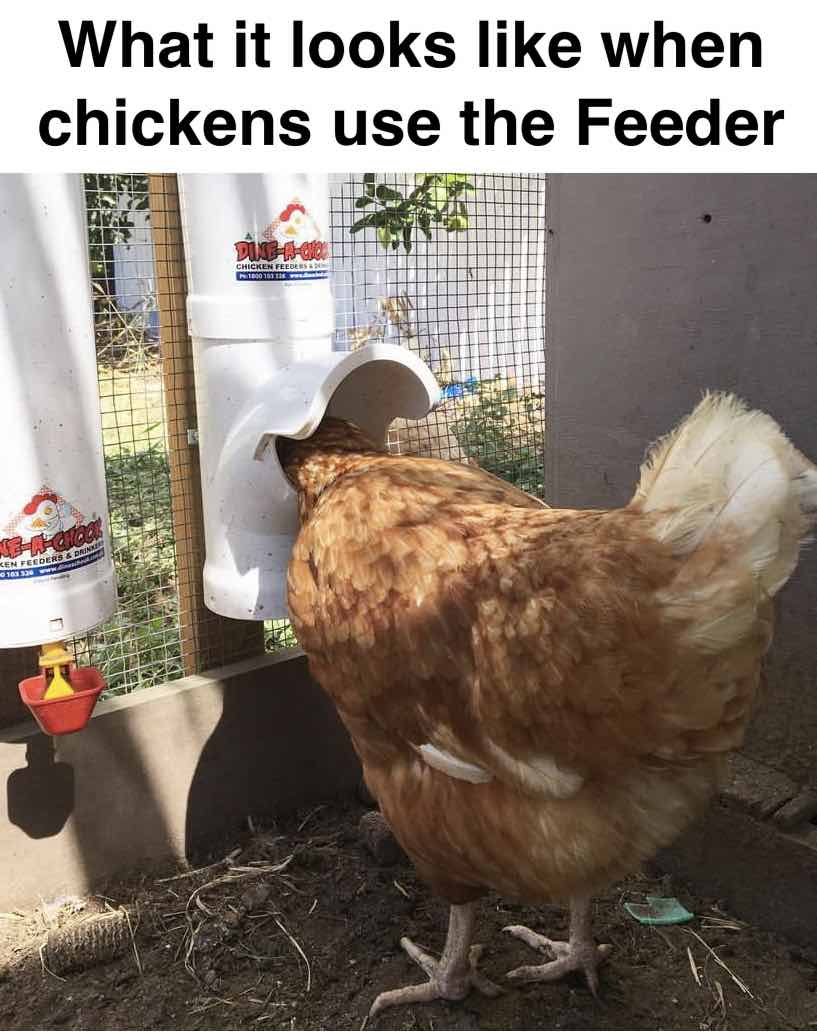
FAQ: Why isn’t the feeding bay refilling?
Dine a Chook Feeders are designed so that the feeding bay refills automatically as your chickens consume the feed.
If the feeding bay is not automatically refilling, there are a few common causes:
- The feeding bay could be too shallow and be stopping the feed from refilling freely. See below for how to adjust the depth to allow the feed to flow into the feeding bay freely.
- You could be using a sticky feed which has clogged the feeder. Molasses-coated grain mixes are notorious for this.
- Something is blocking the feeding bay inlet. This is usually a sticky feed but could also be a piece of debris. We haven't yet found a commercial feed that is big enough to block the inlet when the feeding bay is at full depth.
- The Feeder is empty.
FAQ: How do I change the feeding bay depth?
The feeding bay depth is easy to change.
The bottom of the Dine a Chook Feeder is an interior fitted screw cap. This cap makes it possible to adjust the feeding bay depth (it is also easy to remove for cleaning). Screwing the cap moves it up and down, adjusting the depth of the feeding bay inside.
To adjust the depth of the feeding bay, hold the feeder horizontally with the feeding bay facing up and the lid on. Screw the bottom cap and you will be able to see and feel whether the feeding bay is getting shallower or deeper. Adjust the feeding bay depth as required.
FAQ: When should I change the feeding bay depth?
The feeding bay depth will make a difference to how easily your chickens can access the feed. For smaller hens, a shallower feeding bay may make it easier for them to eat.
Feeding bay depth is also important for ensuring the feeding bay automatically refills with feed from the feed silo. Larger feeds require a larger space between the bottom of the silo and the bottom of the feeding bay, so the feeding bay needs to be deeper or it won’t automatically refill.
FAQ: Cleaning a Dine a Chook Feeder
We recommend cleaning out the bottom of the feeding bay every few weeks by removing the bottom interior-cap. Give your Feeder a thorough clean as needed.
If you need to clean your Dine a Chook Feeder, simply wash in warm soapy water (not hot). Remove the bottom interior-cap to clean the feeding bay thoroughly.
Rinse well and allow to dry completely before reassembling.
Our Feeders should never be put through a dish washer.
Is there a question we haven't answered? Please contact us and we will be able to help!


